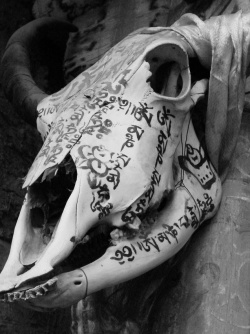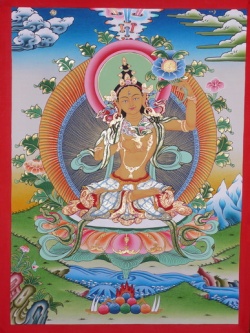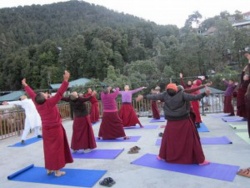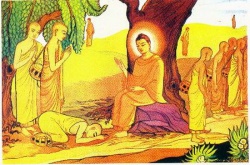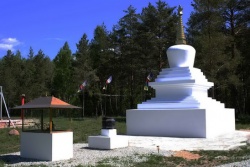The Koan Q & A
Q: What is the basic purpose of koans?
A: Mainly to put a stop to representational thinking.
Q: Just what exactly do you mean by representational thinking?
A: Basically, representational thinking deals with the habitual use of mental images at a very subtle level. The major problem with such thinking is that we believe it matches the object it tries to represent. But it doesn't. From a Buddhist standpoint, no representation can match our Buddha-nature. And as long as we try to visualize this nature, we are just going to run around in circles.
Q: If I am given a koan, then, I am expected to perceive what is not a mental image--breaking my habit of representational thinking--right?
A: Yes...that's right. But surmounting such thinking, especially for us moderns, is really difficult. Often, we fail to arrive at the limit of representational thinking. Some even go so far as to represent non-representational thinking! Talk about delusion!
Q: Could you explain how all this pertains to the "Mu" koan about whether or not a dog has the Buddha-nature?
A: As you know Joshu replied to the question with "Mu", meaning "No". This came as a shock to the questioner who believed that all sentient beings, including a dog, have the potential to realize Buddhahood in the future. In regard to the koan exercise, itself, as laid out by Chinese Zen master Ta-hui, Joshu's "Mu" is called a *hua-wei* meaning "word-tail". For the practitioner thinking "Mu" in his mind's eye, it is merely a hua-wei, being no more than a mental image, or more precisely, a mental sound. In the exercise, itself, hua-wei chiefly refers to representational thinking. "Mu", let us say, is the grand representation of all! Imagine, then, trying to transcend "Mu", seeing the *pure antecedentness* of the hua-wei called the *hau-t'ou*, meaning 'ante-word'. But that is what we have to do. Basically, this means to look at the suchness which comes prior to the arising of Mu in our mind's eye. If we look correctly, we will see the first trace of Buddha Mind, understanding that the myriad of things issue from this abode which is free of mental images.
Q: Are you saying that the "Mu" I intone in my mind comes from Buddha Mind which cannot be intoned or seen?
A: Yes. However, most people are so addicted to representational thinking that they are unable to see anything besides the hua-wei side, in this case, the imagined "Mu" which is not the same as the real antecedent "Mu". Continuing this way, they will never get a glimpse of Buddha Mind. I should say, to actually merge with the hua-t'ou of "Mu" proves a great event if it is actually accomplished. But most practitioners never do it.
Q: Why is that?
A: It is because most people believe in the seen rather than the unseen. In the world of mental constructs, we have been led to believe that the source of thoughts is nothing--it is a dream. We are taught to value thoughts, schemata, feelings, desires and so on. Never once have our cultural wise men encouraged us to investigate the true source of these images.
Q: When you saw the hua-t'ou--the "pure antecedentness" as you call it--what was it like?
A: I just saw *that* which was image-free. No matter what image came before my mind I could see its hau-t'ou. It was great! I can remember the next morning as I watched the sun rise over the eastern hills and saw its hau-t'ou and jumped for joy like a madman! Then, when I went in the woods to cut firewood, I even felt the hau-t'ou of sawing wood! Even when my old fears came up, I could see the hua-t'ou. Over the years as my practice deepened, I became more of the the hau-t'ou and less and less of the hua-wei. As this happened, more of the Buddha's teaching was revealed to me. Oh, let me say this before I forget--Zen practice really begins after we see the hau-t'ou, and not before.
Q: That is very interesting. So, there comes a point when you actually "see the hua-t'ou" of "Mu". Right?
A: Yes--exactly so. No "ifs" "ands" or "buts" about it. You see *that* which no image can represent. In addition, it is like a mysterious jewel which, if you turn to it, your existence becomes more complete over time. The more you look at it, the clearer your Buddha knowledge becomes.
Q: That seems easy enough. But what about bigger koans like Hyakujo's fox? I really have a difficult time with that one. How did Hyakujo's words "The enlightened man is one with causation" free the Zen master from further rebirth as a fox?
A: The teacher of Ta-hui, Zen master Yuan-wu, said, "Do not seek for anything within the meaning of the phrase". What he was stressing is that you must learn to hear clearly outside of the phrase in the example of "The enlightened man is one with causation". That is the hua-t'ou. Do you understand?
Q: Not exactly. I am familiar with a number of interpretations of that particular koan. Do you mean they are wrong and yours is right?
A: [laughing] No, only truth has the correct answer. But let me now get to the point. Teachers who engage in looking for the various meanings in koan phrases themselves, are off the track. If a thousand Zen masters have a thousand different interpretations of Hyakujo's answer, which one should we follow? These teachers are only investigating dead words. They should see the live word that comes before all words!
Q: So what is the "live word", as you say?
A: It is where the hau-t'ou is. Exactly there! It is the source of my tongue which not even the Buddha can find! [laughing]
Q: Well, I must admit that is a pretty good answer. In other words, I have to get beyond representational thinking, as you say, and stop trying to conceptualize. By the way, I have heard a lot about "doubt" in koan practice. What does it mean?
A: When the pioneer of the koan exercise, Yuan-wu, used the expression "doubt", he meant it to refer to obstacles which Zen practitioners must overcome. Basically, in Yuan-wu's use, it is what separates us from the truth.
Q: But I read somewhere that we are supposed to cultivate "great doubt".
A: Oh, that was Ta-hui's understanding of doubt who was Yuan-wu's successor. He said that "great doubt is followed by great enlightenment", or something to that effect.
Q: What is your assessment of the way koans are practiced today?
A: To be honest, not very good. It is much like Yuan-wu's time, in which everyone was stuck on interpreting koan phrases, which, ironically, koans were designed as an antidote against. It seems to me, that we haven't changed a bit. Today, the only difference is that teachers now are analyzing koans from various psychological perspectives. They treat koans as if they were psycho-social parables which, of course, they are not.
Q: Aren't there answer to koans?
A: Not in a mundane sense, although in Japanese Rinzai Zen there are pat answers. But this is like giving out pictures of cookies to stop hunger. Thankfully, some crazy Zen master in 1916 gave out the answers to Hakuin's koan system and spared us all pictures of cookies! By the way, he called such Zen "pseudo-Zen".
Q: Does that mean, therefore, there are no answers?
A: It was never the intention of Ta-hui, or his teacher, to give 'word answers' to koans, in the case of riddles. When you penetrate the hua't'ou of the phrase you will know the right spiritual answer. If I say, "Mu" or "Cypress tree in the courtyard", or put my shoes on my head--you will understand. If I say, "Buddha" or chant a mantra, it is the same answer. That comes from seeing the hua-t'ou.
Q: Basically, you're saying that the modern practice of the koan is incorrect--right?
A: I am not going to answer that one. [laughing] I am already in hot water for my views. That is what you get for trying to be true to the original. I guess that makes me an old conservative Zennist!
Q: Well, you have to admit that what you have said so far, is not found in today's Zen books. To be honest, is your version traditional?
A: Of course, my account is traditional. On the other hand, today's so-called Zen books are, for the most part, the machinations of Pop Zennists who don't have the slightest inkling of how koans work. Basically, on this issue, Zen is divided into two camps, viz., those who wish to go beyond representational thinking and those who are using koans as a vehicle for psychological problem solving.
Q: What do you say when teachers tell their students that their own life is a koan?
A: You mean Dogen's idea? I say that they are looking in the wrong direction. Life is samsara--it never gets anywhere.
Q: Then, you don't think our life has any ultimate meaning?
A: What has ultimate meaning is the deathless hua-t'ou. In contrast with that, our body is a walking corpse looking for a grave. Yet, despite this dismal outlook, each of us has the capacity to harmonize with Buddha-nature, and by harmonizing with it, attain eternal life. After that, we will be like a swan, taking flight from a smelly old lake, flying to heaven.
Q: So, koans help us reach heaven? I can't believe that.
A: Koans help us see the immortal. By the way, I was using a metaphor from the Dhammapada. Yes, the Buddha talks about "swans" and "heaven". Sorry to rain on your parade! [laughing]
Q: It is going to take me a while to digest what you have said. For some who have spent years in study with a teacher, your words are depressing. In effect, you are suggesting that my Zen is not Zen because my answers dealt with psychological issues.
A: If I am suggesting anything it is this: China once greatly valued spirit. When the great Chinese mind developed Ch'an (Zen) it was for the purpose of spiritual transcendence--not learning how to cope with everyday life and the kids. In other words, there was only super swan flying Zen! [laughing]
Q: If Zen can't deal with common everyday issues, how can it be any good?
A: The problems people face today are not spiritual problems, but problems of desire and excess. In this regard, not even a Sage can be of any benefit. Only nature and Fate can deal with such people, teaching them their hard lessons. Spirit, on the other hand, says that if you want true happiness, leave your madhouse behind and move towards a higher level of being. The koan helps us do that.
Q: Does answering a koan correctly make one a Buddha?
A: Absolutely not. The answer only points you in the right direction. You just see a little bit of our Mr. Buddha! The insight still has to be cultivated until you manifest the state of Bodhisattva. After you become a Bodhisattva, a whole new practice evolves. Koans, after that, are like reading children's books.
Q: Does that explain why the Bodhisattva path is not mentioned very much in Zen?
A: I think so. But I should point out in Zen's beginnings, uncovered in old Tibetan manuscripts, there were roughly four kinds of Zen, viz., Gradual Zen, Sudden Zen, Mahayoga and Tathagata Zen. Mahayoga was basically the Bodhisattva path which lead to Tathagata Zen. What I think has happened now, is that Mahayoga and Tathagata Zen have been replaced by Sudden Zen. The higher forms of Zen, namely, Mahayoga and Tathagata Zen remained in Tibet and were subsequently absorbed.
Q: That is fascinating. I hope I haven't taken up too much of your time.
A: That's okay. I am glad to share my thoughts with you.
